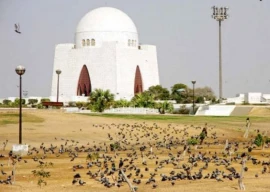A small revolution is brewing in some 30 villages in Dadu district’s Johi taluka in Sindh. A group of people, mostly men, are trying to end the age-old practice of child marriage.
These are local journalists, youth, nikahkhwans and people from within the communities who are like-minded.
"Child marriage is a norm here," said Mashooque Birhamani, who heads Sujag Sansar Organization (SSO) that works on preventing child marriage. He has been at the helm of this campaign since 2010. Today, he has begun to notice a small but nevertheless a significant change.
While there are no separate statistics on child marriages in Sindh, according to the latest Pakistan Demographic and Health Survey (2012-13), in Pakistan as a whole, eight per cent of adolescent women (between the age of 15 and 19 years) are already mothers or pregnant with their first child. However, teenage fertility has halved since 1990-91.
"We have formed anti-child marriage committees, one each in some 30 villages in Dadu. As recent as last month, two such committees stopped two child marriages. The recent law against child marriage has come as a useful arsenal in our campaign," said Birhamani.
Last year, after the passage of the Sindh Child Marriage Restraint Act 2013, the legal age for marriage in Sindh province was raised to 18. Those flouting the law face imprisonment which may extend to three years and a fine. A bill introducing harsher penalties for marriage under the age of 16 was also adopted.
Read: Ending the practice: Social activists in K-P, FATA welcome child marriage resolution
But few in the villages know and fewer still care. They must follow traditions, they say.
To Dr Yasmeen Sabih Qazi, senior country advisor, population program with the David and Lucile Packard Foundation, a strong awareness and sensitization campaign is the key to bringing change in the mindset of communities. "It also needs local government's vigilance to ensure that no underage marriage is taking place and that the nikahkawan must make it mandatory to confirm the girl's age."
The SSO is doing just that. It is training nikahkhwans. "When we began our work, there was only one maulvi who was registered; we got seven of them registered."
Maulvi Mohammad Amin, a well revered and much sought after maulvi is among the trained ones. Today he goes from village to village educating people about the hazards of early marriage. Moreover, when parents come to him for the nikah service, he asks for the CNIC of the bride and groom and if that is not available, he asks for their age. If he is not satisfied, he refuses. "People listen to him," said Birhamani.
Since 2010, when SSO began work on child marriage in earnest and suffered social boycotts and threats, they have been able to preempt and stop 30 such marriages in these villages.
In many parts of Pakistan, since the age of the child is often unknown, it is measured in several other ways. If the girl-child is able to pick up an earthenware pitcher filled with water and carry it on her head, she is ripe for marriage. Another is that after her first period, it is 'haram' to have her living in her parents’ house.
Marrying daughters young has its benefits too, many parents counter. "Apart from following the tradition, parents don't have to worry about her future; sometimes the bride's family gets money in exchange and at times debts are settled in exchange of daughters (vani /swara or watta satta). Often parents feel their daughter won't be left unprotected after they are gone," said Birhamani.
"My cousin Asma got married three years ago when she was 15. She has three kids and her husband does not work. She is weak and tired all the time and has taken up tailoring to feed her children. She keeps telling us not to get married," says 19-year old Shaheena Anwar who lives in Johi city and is studying for her Intermediate exam. "On seeing Asma's plight, my father and even my uncle are convinced I should not meet the same fate," she said and added, "But my mother is worried that if I don't, soon the proposals may stop coming."
"We know that the more education a girl has, the later she is likely to marry, the fewer children she will have and the more likely she will be able to generate a safe and regular income to help keep herself and her family healthier and more prosperous,” said Lakshmi Sundaram, executive director of Girls not Brides.
The effort of SSO is finally bearing fruit. Only recently, Birhamani was able to arrange a bus to transport a bus load of more than 33 girls from Allah Bachayo village to the city some 21 km from it so that they could sit for their matriculation exam. "This was a village where just five years back, girls dropped out of 5th class when they reached puberty."
While their proposals for marriage have steadily been coming, the girls have resisted all attempts by their parents and relatives to marry them off and made it up to Class 10 which is no small feat.
There is strength in numbers they say. "They said because they were so many, they were able to get their way," said Birhamani.
Parents, too, are slowly learning through their children that there are dangers of marrying young.
"I would say the change has come about through theatre that these girls are part of since they were in smaller grades,” said Birhamani, explaining how the sensitisation worked. “They have learnt important lessons - that they have the right to education; that the legal age of marriage is 18, that till then a woman's body is not ready to bear babies, that consent of the girl is mandatory in Islam, and that learning a skill can make them economically empowered and as strong as their brothers.”
Where will child marriage fit in the sustainable development goals?
The Millennium Development Goals (MDGs) are set to come to an end in 2015. There was however, scant attention paid to the needs of adolescent girls and in particular the issue of child marriage. In fact, Sundaram said child marriage was a barrier to many of the world’s most challenging development issues and had "hindered efforts to achieve six of the eight MDGs." For example goal three, which promotes "gender equality and empower women”, makes no mention of child marriage.
But as the MDGs end, replaced by a new set of goals - Sustainable Development Goals - to transform the world by 2030, activists like Sundaram insist the importance of including the issue of child marriage into SDGs. According to Girls Not Brides, this practice traps 15 million girls each year into a cycle of poverty, ill health and inequality.
"We therefore have to prioritise tackling child marriage within the SDGs, if we want to achieve a range of other goals, including those on poverty, nutrition, health, education, gender equality, economic growth and reduction of inequality," she said.
When the process to help shape the next step of international development goals began, Pakistan had proposed inclusion of a target to end child marriage by 2030.
Published in The Express Tribune, July 10th, 2015.

1731570357-0/elon-musk-(1)1731570357-0-165x106.webp)
-(1)1717678110-0/Kendrick-(1)-(1)1717678110-0-165x106.webp)





1732428532-0/BeFunk_§_]__-(43)1732428532-0.jpg)








COMMENTS (1)
Comments are moderated and generally will be posted if they are on-topic and not abusive.
For more information, please see our Comments FAQ